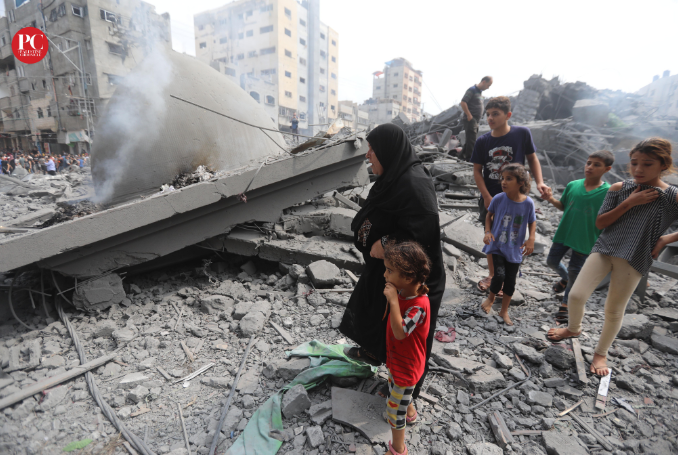
By Jeremy Salt
These massacres bring us closer to the central questions that the inquiring mind might ask about the Gaza genocide.
Every genocide is different from the one before. Organized extermination is their similarity, but no two genocides are the same. They are not unique except in themselves.
In fact, history is in part a running sequence of genocides or ‘mass killings’ or ‘extermination events,’ if you can’t make up your mind how to describe them. There is nothing unusual about them. It is what we “human animals” – to apply Yoav Gallant’s pejorative description to the reality of what we all are – regularly do to each other.
Genocides (to use the word) are usually described as such only after the event. They are never stopped in progress, a curiosity in itself. It is not that they can’t be stopped. They aren’t stopped because the people who could stop them choose not to stop them, for different reasons on every occasion.
How is the current genocide in Gaza different from previous genocides? Does it have a specific character, set against the benchmark of the ‘industrial’ genocide of Jews by the Nazis. It was its assembly-line nature, not numbers that defined that particular event. Otherwise, a far greater number of human beings were killed in other genocides.
The European genocide of Africans in the 19th century was a long-running affair that took the lives of perhaps 60 million people. Black lives were hardly worth counting at the time, by Europeans, and now there are only estimates that 10-12 million died just in King Leopold’s ‘Congo Free State.’
Of course, ‘died’ is a completely dissociative word to describe the gruesome reality of how they ‘died.’
The figures in multiple millions are stamped on the map wherever European armies arrived, to stay. This is not to stay that the people in these territories did not butcher each other before the Europeans arrived. They did but the Europeans brought with them far more effective means of controlling and killing, in as large a number as might be necessary to ‘tame’ the locals.
We know about these events from what we can read or see in documentaries. We have the written word, accurate or not, and the artist’s impression, of Gordon standing bravely on top of the stairs in Khartum as the wild-eyed savages rush up at him with spears in hand. The camera in war photography was first used in the Mexican-American War of 1847 but images of dead bodies on the battlefield were not shown until the American Civil War. We see them, but not in the way we are able to see dead bodies now.
Almost everyone old enough to remember the Second World War is now dead. Even a child born in 1939 would have hazy memories and a child born in 1943-45 would have none at all so even people now in their 80s would have no direct memory of the war but being closer to it, in time, and more directly affected by it in many ways, they might when young have been more driven to think, read and write about it.
Since that time the number of mass killings/genocides has proliferated. As bad as they were at the time, most left hardly a dent in history. Who except the victims now remembers Setif, Guelma, and Kharrata, May 8, 1945, west of Constantine, Algeria, where 6000-45,000 people were killed by French ‘authorities’ and pied noir French colonists in retaliation for ‘riots’ in which more than 100 settlers were killed? If no real effort was made to count the Algerian dead, that was because their lives or deaths were of little account to the colonial authorities, and for official purposes the lower the number the better.
Korea, 1950: more mass killings, from the air and by soldiers on the ground. In June-July 1950, 7000 people – ‘communists’ – are massacred by South Korean militias in the Daejong ‘Valley of death.’ 700-900 doctors, nurses, and patients, including about 100 South Korean soldiers, are massacred at the Seoul National University Hospital by the KPA (Korean People’s Army).
In January 1951, Picasso created ‘Massacre in Korea’ as a protest against massacres by US troops as they moved forward. In three years the war ‘takes the lives’ of about three million Koreans, massacred, starved, tortured to death, or otherwise obliterated.
The US dropped 635,000 tons of bombs on North Korea, including 32,557 tons of napalm bombs, leveling virtually all towns and cities and destroying 85 percent of all buildings, about the same percentage of buildings destroyed by Israel in Gaza.
Move forward to Vietnam, another three million dead, and more massacres, the worst (?) perhaps but so far best known at My Lai, where in March 1968 US troops of Charlie Company raped, tortured, mutilated, and murdered close to 500 women and children, including babies. But for Ron Haeberle, who photographed the bodies lying in a ditch, on a path, under a bridge, and Seymour Hersh, who brought the news to the world, the world would have never known. One soldier killed with a cigarette hanging out of his mouth, as apparently disinterestedly as a cleaner mopping the floor.
Srebenica, July 1995: more than 7000 Bosniak men and boys murdered by Serbs, but by this time the US has already launched its first war against Iraq, a war on ‘the enemy as a system,’ which means filleting Iraq like a fish, leaving it without highways, sewage, electricity and water systems and airports so the military is disabled and the civilian population can hardly survive: civilian dead/killed 1991-94 around 200,000, with an estimated half a million children killed as the direct/indirect result of war and sanctions between 1991 and 2002.
One more massacre, in the 1980s, refugees murdered silently at night as men armed with knives moved through their camp and struck silently before they even knew they were there. By morning 1500-3500 are dead, along with their horses and other living animals. There are no men to protect them, while the contract killers with knives are protected by the army ringing the camp and even turning on the spotlights at night so they can see what they are doing. This of course is Sabra and Shatila, Beirut, in September 1982.
In the earliest of these massacres, we have only black and white photos before us. The quality is not good. They speak to us silently, the same crumpled and bent bodies with gashed faces and eyes staring back at us asking ‘why?’ The paths on which they lie and the ditches into which they have been shoved or rolled after being shot could be the same, transferred from Setif to My Lai.
Color photographs do not bring the bodies back to life but they do shorten the distance between life and death. What makes them truly and horribly dead in the Sabra and Shatila photographs is the intense heat, swelling the bodies to bursting point before they were carried away by bulldozers and buried in mass graves, some of which lie under the foundations of reconstructed Beirut.
Apart from color, Lebanon marked the appearance of cable television – CNN – in the reporting of world news. Viewers in their homes could see the war as it was happening in Lebanon and it did not reflect well on the Israelis, seriously disrupting their claims of a righteous war being fought by righteous means.
Correctly, the Israelis claim they did not do the actual killing in Sabra and Shatila but even the Nazis left quite a bit of the killing in the reliable hands of their iron guard brigades in Ukraine and the Baltic states.
The Israelis still killed close to 20,000 people in Lebanon, mostly civilians bombed from the air in their homes.
These massacres bring us closer to the central questions that the inquiring mind might ask about the Gaza genocide, whether the Israelis agree that it is a genocide or not. What makes it different from other genocides? Does it have any specific characteristics of its own? In some ways is it worse than other genocides we know about?
One difference is that those far from the scene have never seen a genocide until now, have never witnessed one, in the sense of being able to provide compelling ‘eyewitness’ evidence of what they saw.
Now, we can actually watch as a missile destroys an apartment building, as a sniper cuts down a young man watching on the beach, as a missile strikes a hospital compound, as body parts are strewn across a street. The soldiers themselves proudly record their own evil deeds, from the destruction of homes and classrooms to the demolition of government offices and universities.
The western media is still prevented from entering Gaza unless it is embedded with an Israeli army unit so it will only be able to report what Israel wants the world to see, not what it needs to see and wants to see.
Thanks to the incredibly brave Palestinian journalists we are able to see not everything but still enough to horrify us. Their courage is the reason the Israeli government continues its strenuous efforts to destroy them: what cannot be reported might as well never have happened.
In fact, the Gaza genocide does have some characteristics that differentiate it from others. One is the number of children killed, by August 2024 almost 17,000 out of an estimated 40,000 civilian deaths, more than 2100 children under the age of two among them.
Thousands of children are still missing, dead and buried in the ruins of their homes; tens of thousands have been left with life-changing injuries such as the loss of arms or legs and close to 20,000 have not just been orphaned but left without anyone in their immediate or extended family to look after them. All are dead except for them, and in many cases, all the children are dead, too: the family name no longer exists in Gaza except as memory.
There is evidence that snipers are deliberately killing children as well as adults caught out in the open. They are arriving in the hospital with head wounds that indicate targeted shots while they are playing in their homes or on the streets. In one case that horrified the world, Hind al Rajab, 6, was trapped for hours in the wreckage of the family car, shelled by a tank, along with the only other surviving member, her sister, until she was killed.
Hind herself made desperate calls for help before she too was killed and the two paramedics were finally allowed to come to her aid shelled by a tank and killed in their ambulance. Already by the end of October 2023, UNESCO was describing Gaza as “a graveyard for thousands of children.”
None of this is accidental or “collateral” damage. 47 percent of the Gazan population is under the age of 18 and the Israelis know when they fire missiles or into apartment buildings or the schools and hospital compounds where refugees have sought shelter that they are going to kill children.
Outrage over the death of Jewish children on October 7 continued in the western media for months.
In March 2024 Israel’s Child Safety Council put the number at 48, many of them the victims of Israeli tank or missile fire, with a further 47 captured and taken into Gaza. Totally ignored in the media was the number of Gazan children killed in Israeli attacks in previous years before Hamas retaliated: 313 in 2008/9, 551 in 2014, close to 50 shot by snipers celebrating their accuracy during the ‘Great March of Return’ (2018/19).
The overwhelming number of Palestinian children massacred after October 7 – 16, 456 by mid-August 2024, with the number rising every day – did not attract even condemnation by ‘western’ governments.
Only one word lies at the bottom of this inability to respond: racism. Had these children been Jewish or Christian and their skins white instead of brown, the number of dead would never have reached a fraction of this number without the collective ‘west’ intervening to stop the killing.
Along with the massacres of children is the killing of their teachers, the destruction of their schools and homes, their books and their computers and the psychological trauma suffered by the survivors. Children are also being used as human shields. Following the downsizing of the Oketz canine unit, the Israeli military has been sending elderly civilians and children underground with cameras attached to their bodies as they “cleanse” the tunnels. “Our lives are more important than their lives, “ Haaretz newspaper reported their commanders as saying.
Women and girls follow children as a distinct category of suffering. By May 2024 UN human rights experts reported that 63 women including 37 mothers were being killed every day: at least 10,000 women had been killed and 19,000 injured since October 7. Miscarriages had increased by up to 300 percent because of malnutrition and lack of access to adequate health care.
Even in the early stages of the war women were giving caesarean birth without anesthesia because of the denial of medical supplies. Unborn children are dying in hospitals and live children of starvation.
An estimated 155,000 pregnant women or new mothers lacked basic health care and were food insecure, the experts found. Close to 700,000 menstruating women and girls had no access to pads, toilets and toilet paper and even running water. Detention and the torture and sexual assault of women and girls by their Israeli captors is another strand of their calculated mistreatment.
A third specific category is the destruction of hospitals and the murder of medical personnel. By May 2024, 31 of Gaza’s 36 hospitals had been damaged or destroyed. In the few hospitals still functioning at a severely reduced level, more than 9000 patients were at serious risk of dying because of the lack of health care. The WHO reported 890 Israeli attacks on health facilities since October 7, not just in Gaza but on the West Bank, including the deliberate destruction of hundreds of ambulances. At least 500 healthcare workers and 278 aid workers have been killed.
The Shifa hospital – Gaza’s biggest – was subjected to a sustained military assault until it was inoperable as a hospital. In May 2024 the UN human rights experts reported that a further 390 bodies – women and children included – had been uncovered at the Shifa and Nasser hospitals, many showing signs of torture, summary execution and even having been buried alive.
The treatment still available in hospitals is tested still further with every mass casualty. The conditions are already like a death chamber, with doctors inside struggling to save the living. The medical staff is worn out, traumatized, and hardly able to cope after almost a year of Israeli savagery.
Two American surgeons described the situation when they arrived at the European Hospital as “what we imagined the first weeks of what a zombie apocalypse would look and smell like.” (Mark Perlmutter and Feroze Sidhwa, ‘We Volunteered at a Gaza Hospital. What We Saw Was Unspeakable,’ Politico Magazine, July 19, 2024).
Does the Gaza genocide only seem worse than others because it is the first in history that genocide can be seen ‘happening’ in real-time or in some respects is this one really worse? In response, while women and children are always killed in war, if the Gaza genocide is stamped with one particular characteristic it is surely the mass killing of children, focused, relentless, pitiless, and remorseless.
As long as it lives, Israel will never get away from this. The dead children of Gaza will follow it, and haunt it until the end of time. The ‘genocide of children,’ of the totally innocent, will never be forgotten as long as Israel lives.
Older ‘liberal’ Israelis are shocked. They say this is not the Israel they grew up in but it always was. They just didn’t see it, didn’t want to see it or were too deeply indoctrinated to see it.
The evidence is all there in the hundreds of villages destroyed and depopulated and the people massacred all the way up to 1967, including children as sweet and innocent as those obliterated in Gaza. The Gaza subset of a long-running genocide is the evil fruit of seeds sown long ago.
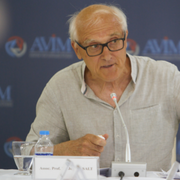
– Jeremy Salt taught at the University of Melbourne, at Bosporus University in Istanbul and Bilkent University in Ankara for many years, specializing in the modern history of the Middle East. Among his recent publications is his 2008 book, The Unmaking of the Middle East. A History of Western Disorder in Arab Lands (University of California Press) and The Last Ottoman Wars. The Human Cost 1877-1923 (University of Utah Press, 2019). He contributed this article to The Palestine Chronicle.

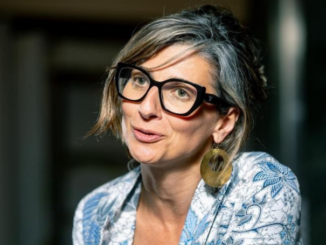
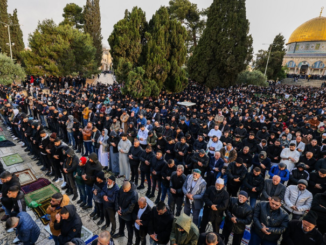




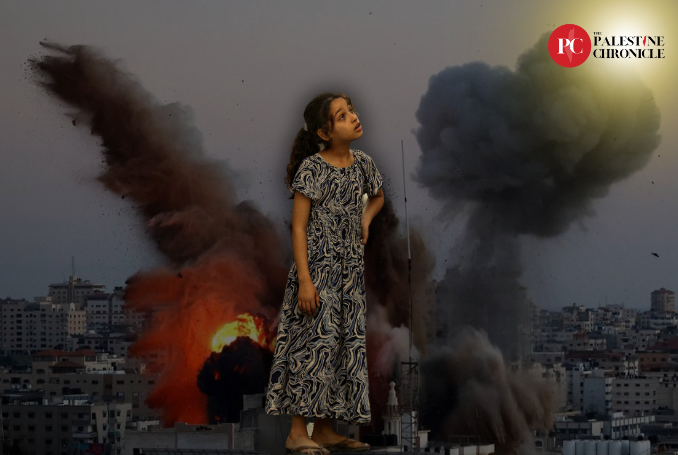
I’m surprised that in your coverage of genocide you neglected the 1915 Genocide of Armenians by Turkey, During the seven-year longgenocide, the first in the 20th century, more than half the total population was killed. Many who survived were forcibly Turkified or if children adopted and their identity hidden from them. In addition to the elimination of Armenians, Turkey grabbed 90% of historic Armenia. To this day, Turkey denies the genocide and along with Turkic Azerbaijan threatens the remaining 10% of Armenia. Partly because of their experience, Armenians are pro- Palestinian. PA’s ambassador to Denmark is Palestinian Armenian and an Armenian professor is a member of PA cabinet.
It isn’t a good look to centre your disappointment that one of the many terrible genocides of history was not mentioned as a comparative example.